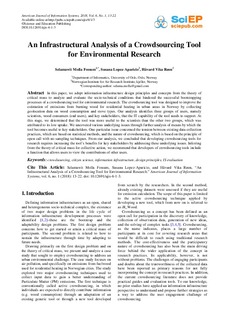| dc.contributor.author | Fossum, Selamawit Molla | |
| dc.contributor.author | Lopez-Aparicio, Susana | |
| dc.contributor.author | Røen, Håvard Vika | |
| dc.date.accessioned | 2018-05-15T10:14:33Z | |
| dc.date.available | 2018-05-15T10:14:33Z | |
| dc.date.created | 2018-05-08T12:50:17Z | |
| dc.date.issued | 2018 | |
| dc.identifier.citation | American Journal of Information Systems. 2018, 6 (1), 13-22. | nb_NO |
| dc.identifier.issn | 2374-1988 | |
| dc.identifier.uri | http://hdl.handle.net/11250/2498138 | |
| dc.description.abstract | In this paper, we adopt information infrastructure design principles and concepts from the theory of critical mass to analyze and evaluate the socio-technical conditions that hindered the successful bootstrapping processes of a crowdsourcing tool for environmental research. The crowdsourcing tool was designed to improve the estimation of emissions from burning wood for residential heating in urban areas in Norway by collecting geolocation data on wood consumption and stove types. Our analysis identifies three groups of users, namely scientists, wood consumers (end users), and key stakeholders, that the IT capability of the tool needs to support. At this stage, we determined that the tool was more useful to the scientists than the other two groups, which was attributed to its low uptake. We uncovered various underlying issues through further analysis of means by which the tool becomes useful to key stakeholders. One particular issue concerned the tension between existing data collection practices, which are based on statistical methods, and the nature of crowdsourcing, which is based on the principle of open call with no sampling techniques. From our analysis, we concluded that developing crowdsourcing tools for research requires increasing the tool’s benefits for key stakeholders by addressing these underlying issues. Inferring from the theory of critical mass for collective action, we recommend that developers of crowdsourcing tools include a function that allows users to view the contributions of other users. | nb_NO |
| dc.language.iso | eng | nb_NO |
| dc.rights | Navngivelse 4.0 Internasjonal | * |
| dc.rights.uri | http://creativecommons.org/licenses/by/4.0/deed.no | * |
| dc.title | An Infrastructural Analysis of a Crowdsourcing Tool for Environmental Research | nb_NO |
| dc.type | Journal article | nb_NO |
| dc.description.version | publishedVersion | nb_NO |
| dc.rights.holder | ©Science and Education Publishing | nb_NO |
| dc.source.pagenumber | 13-22 | nb_NO |
| dc.source.volume | 6 | nb_NO |
| dc.source.journal | American Journal of Information Systems | nb_NO |
| dc.source.issue | 1 | nb_NO |
| dc.identifier.doi | 10.12691/ajis-6-1-3 | |
| dc.identifier.cristin | 1584131 | |
| dc.relation.project | Norges forskningsråd: 247884 | nb_NO |
| dc.relation.project | NILU - Norsk institutt for luftforskning: 115070 | nb_NO |
| cristin.unitcode | 7460,54,0,0 | |
| cristin.unitcode | 7460,53,0,0 | |
| cristin.unitname | By og industri | |
| cristin.unitname | Software- og hardwareutvikling | |
| cristin.ispublished | true | |
| cristin.fulltext | original | |

